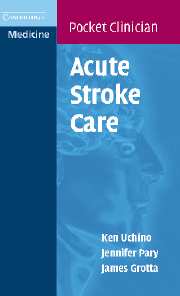Book contents
- Frontmatter
- Contents
- Preface
- List of abbreviations
- 1 Stroke in the emergency department
- 2 What to do first
- 3 Ischemic stroke
- 4 TPA protocol
- 5 Neurological deterioration in acute ischemic stroke
- 6 Ischemic stroke prevention: why we do the things we do
- 7 Transient ischemic attack (TIA)
- 8 Intracerebral hemorrhage (ICH)
- 9 Subarachnoid hemorrhage (SAH)
- 10 Organization of stroke care
- 11 Rehabilitation
- Appendix 1 Numbers and calculations
- Appendix 2 IV TPA dosing chart
- Appendix 3 Sample admission orders
- Appendix 4 Sample discharge summary
- Appendix 5 Stroke radiology
- Appendix 6 Transcranial Doppler ultrasound (TCD)
- Appendix 7 Heparin protocol
- Appendix 8 Insulin protocol
- Appendix 9 Medical complications
- Appendix 10 Brainstem syndromes
- Appendix 11 Cerebral arterial anatomy
- Appendix 12 Stroke in the young and less common stroke diagnoses
- Appendix 13 Brain death criteria
- Appendix 14 Neurological scales
- Recommended reading
- References
7 - Transient ischemic attack (TIA)
Published online by Cambridge University Press: 10 October 2009
- Frontmatter
- Contents
- Preface
- List of abbreviations
- 1 Stroke in the emergency department
- 2 What to do first
- 3 Ischemic stroke
- 4 TPA protocol
- 5 Neurological deterioration in acute ischemic stroke
- 6 Ischemic stroke prevention: why we do the things we do
- 7 Transient ischemic attack (TIA)
- 8 Intracerebral hemorrhage (ICH)
- 9 Subarachnoid hemorrhage (SAH)
- 10 Organization of stroke care
- 11 Rehabilitation
- Appendix 1 Numbers and calculations
- Appendix 2 IV TPA dosing chart
- Appendix 3 Sample admission orders
- Appendix 4 Sample discharge summary
- Appendix 5 Stroke radiology
- Appendix 6 Transcranial Doppler ultrasound (TCD)
- Appendix 7 Heparin protocol
- Appendix 8 Insulin protocol
- Appendix 9 Medical complications
- Appendix 10 Brainstem syndromes
- Appendix 11 Cerebral arterial anatomy
- Appendix 12 Stroke in the young and less common stroke diagnoses
- Appendix 13 Brain death criteria
- Appendix 14 Neurological scales
- Recommended reading
- References
Summary
Transient neurological symptoms often present a difficult diagnostic dilemma. It is often difficult to tell if the transient symptoms were due to ischemia or due to something else (see Chapter 1). Usually, by the time the physician sees the patient, the neurological exam has returned to normal.
On the other hand, it is critically important not to miss the diagnosis of TIA. TIAs may provide an opportunity for physicians to intervene and prevent an ischemic stroke and subsequent disability and must be taken seriously. Search for an etiology must be done expeditiously. Just as angina may serve as a warning for future myocardial infarction, a TIA is often a warning sign of an impending stroke.
Definition
A transient ischemic attack (TIA) is a brief episode of neurologic dysfunction caused by focal brain or retinal ischemia, with clinical symptoms typically lasting less than one hour, and without evidence of acute infarction on brain imaging.
Etiology
The causes are the same as for ischemic stroke. Determining the etiology of the ischemic symptoms expeditiously is very important as there are several causes that, if treated urgently, may prevent a stroke. Such causes include atrial fibrillation and symptomatic carotid stenosis.
Presentation
TIAs present the same way as an acute ischemic stroke. The only difference is that the symptoms and signs rapidly and completely resolve, usually within minutes. There is not a typical presentation – it depends on the vascular territory affected.
Differential diagnosis
Syncope: look for pre-syncopal symptoms.
Seizure: ask about prior history of seizure, or if any of the following occurred with the event: shaking, clouding of consciousness, tongue biting, incontinence.
[…]
- Type
- Chapter
- Information
- Acute Stroke CareA Manual from the University of Texas - Houston Stroke Team, pp. 85 - 90Publisher: Cambridge University PressPrint publication year: 2007

